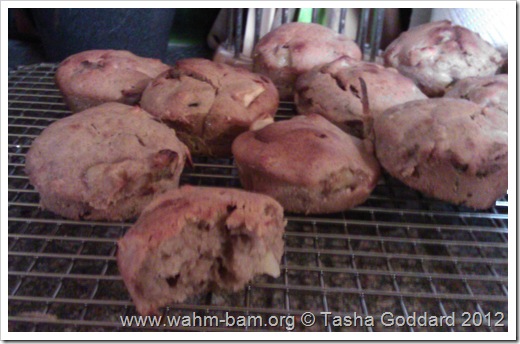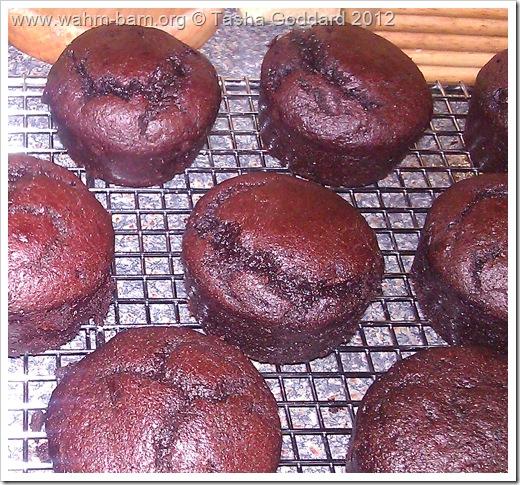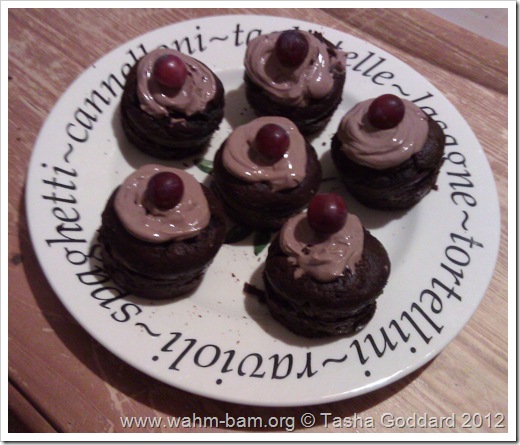Wheat-free, low-GI muffins
I’ve been experimenting a lot with non-wheat flours*, especially low-GI ones, lately. I love baking. And I love eating cake. And, frankly, I think it should be possible to do these things without any adverse effect on the whole losing weight and getting healthier plan. At first, I thought I had it sussed just by substituting the wheat with oats and buckwheat flour, and stuffed myself with delicious oat cookies and muffins. But then it struck me (aside from the fact that the number on the scales was no longer getting smaller) that these still had really a lot of sugar in them (which most certainly isn’t low-GI) and a fair bit of butter too (I tend to use Flora Buttery rather than butter, which does mostly use seed oils, but it’s still not brilliant for you). Ah. So, healthier than those white flour, white sugar and full-fat butter cupcakes, but still not really what you could describe as healthy.
So I started experimenting with reducing the sugar content in my recipes and then I got some wonderful stuff, called Agave Syrup. Agave syrup is a natural sweetener that has a much lower GI than sugar – in fact, it has a lower GI than apple. I’ve been using agave syrup in lots of recipes where I’d have used honey or sugar. And I’m tending to use a cold-pressed oil, such as rapeseed oil, rather than butter (or Flora Buttery).
Anyway, I’m still experimenting – tomorrow, I’m hoping to try some carrot muffins – but in the meantime, here are two recipes that have gone down very well.
Wheat-free apple and banana muffins
Makes 18-24 muffins
Ingredients
2 bananas, mushed
1 tsp vanilla essence
150 ml rapeseed oil***
120g Agave syrup (½ light and ½ dark)
3 eggs
150g barley flour*
100g quinoa flour*
2 tsp baking powder
1 tsp bicarbonate of soda
3 tsp cinnamon powder
2 apples, peeled and grated (or chopped) (wait until you need it before grating, otherwise it will oxidise and look too appealing – though it will still taste fine)
150g sultanas
Method
Using an electric whisk, mix the bananas, vanilla, oil and syrup together (start on a low setting and then up to a high setting for a minute) until well combined.
Add three eggs (yolks and whites – not the shells!) and whisk again (on high) for a few minutes.
Sift the flours, baking powder, bicarbonate of soda and cinnamon powder into the liquid and then mix gently at first and then on high, once the ingredients are well mixed.
Add the apple and sultanas and mix together with a spoon.
Spoon into 18 to 24 silicone muffin cases (or greased muffin tins) and bake at 150°C (300°F/gas mark 2) for 15 to 20 minutes.** If you stick a knife in the middle of one of the muffins, it should come out clean.
Leave in the cases (or tins) for a couple of minutes to cool, then slide a silicone slice round the edges to loosen them all from the tin, then remove them all from the tin and place on a wire cooling tray.
Wheat-free chocolate muffins
Makes 12 muffins
Ingredients
1 banana, mushed
1 tsp vanilla essence
80g Agave syrup (½ light and ½ dark)
100 ml rapeseed oil***
2 eggs
50g cocoa powder
1 tsp baking powder
1 tsp bicarbonate of soda
75g barley flour*
75g quinoa flour*
1 apple, peeled and grated
For optional chocolate cream cheese icing
100g cream cheese (we tend to use Philadelphia)
2 tbsp Agave syrup (light, dark or mixture)
cocoa powder
Method
Whisk together the banana, vanilla essence and Agave syrup.
Add the oil and whisk again.
Add the eggs and whisk again for a few minutes.
Sift the cocoa powder, baking powder and bicarbonate of soda in and whisk on low.
Sift the barley flour in and whisk on low.
Sift the quinoa flour in and whisk on low.
Whisk on high for a few minutes.
Add the grated apple and mix with a spoon.
Spoon the mixture into 12 muffin cases (I always use silicone cases, though presumably a greased muffin tin should work, too).
Bake at 150°C (300°F/gas mark 2) for 15 to 20 minutes.** If you stick a knife in the middle of one of the muffins, it should come out clean.
Leave in the cases (or tins) for a couple of minutes to cool, then slide a silicone slice round the edges to loosen them all from the tin, then remove them all from the tin and place on a wire cooling tray.
If you want to ice them, mix together the cream cheese and syrup and then sift in cocoa powder bit by bit, until you have the consistency you require (you could use icing sugar, but that will serious up the GI and lower the healthiness). These ones are topped with grapes because that’s what I had, but cherries would probably work better. The muffins are delicious without any kind of icing, though.
* A note on the flours I’ve used. I am only trying to reduce my wheat consumption (and lower the GI of my baking). Some of the flours do contain gluten, so would not be suitable for anyone on a gluten-free diet. Barley flour contains gluten and a lot of oats do, too – though you can get gluten-free oats. Buckwheat flour is gluten-free, as are rice flour, potato flour and maize flour, however only buckwheat is really low-GI. Quinoa flour is a good one, too, as it’s gluten-free, low-GI and high in protein. I use a lot of buckwheat flour, but it does have a very strong flavour and RoRo is not very keen on it, particularly in sweet foods like biscuits and cakes. I’ve settled on a combination of barley and quinoa flour for the most part, in particular when making something sweet, or that cannot cope with the distinctive buckwheat taste.
** A note on our oven. Our oven has a broken thermostat. It just keeps getting hot, until it gets so hot it turns itself off and won’t turn on again until it’s cooled down. So, it’s probably a good idea to check your muffins at regular intervals, just in case they’re burning or need a lot more time. 15-20 minutes is usually OK for our oven to behave almost like a normal oven, so these timings should be about right, but do check, just in case.
*** A note about the oils I use. I tend to use cold-pressed rapeseed oil, if I can, but I’ll substitute that with sunflower or vegetable oil and it works fine (not as healthy, though!).
I would love to hear about any wheat-free and/or low-GI baking you’ve done. And I welcome suggestions for new flours (I may be developing a little bit of an addiction – I seem to always have at least six different flours on my shelves) or alternative low-GI sweetening methods. And, of course, if you do try any of my recipes, I would love to hear how they went – good and bad feedback welcome!
Feel free to pin, but please make sure you link back to this page or, at least to the blog.




Leave a Reply